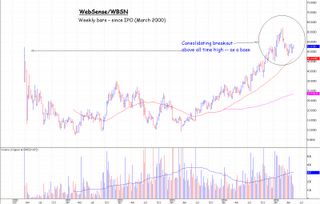WebSense/WBSN
Websense is proof that there's plenty of money to be made from humankind's appetite for vice. The company makes software that lets managers halt employee access to Internet sites that feature porn, gambling and other nonwork-related material. The software also fills some security needs.
It's a lucrative niche. Websense has averaged 91% annual profit growth and 72% annual sales growth over the past five years. "They're benefiting from their leadership position in a hot market," said Pacific Crest Securities analyst Rob Owens. "They've been able to drive their bookings and revenue much faster than I think anyone had anticipated," said analyst Garrett Bekker at Tradition Asiel Securities. "Their operating margins have increased very rapidly..."
Selling by subscription helps, says Websense Chief Executive John Carrington says. Each quarter begins with 80% of revenue already on the balance sheet. "That allows you to really manage your expenses," Carrington said. "Say we shared with the Street an expected earnings per share of x. We can back into that and say, 'How much do we have to make in profit, to make sure we make x?'"
A year's subscription for 1,000 employees runs $15,000, Carrington says. Annual price rises are 4% to 5%. "They have a very efficient business model," Bekker said. "They also bill upfront, so they've got great cash flow."
A software revamp finished last year laid the groundwork for Websense to increase sales. The firm sought to make its software faster, easier to use and better able to accommodate add-ons and upgrades. "It was a massive undertaking," Carrington said. "We professed to the world we were going to change the game - from being just sort of Web management focused to a focus on employee Internet management and Internet security."
Websense rebuilt its software to oversee more than just employee use of the Internet. It now can oversee use of the network and desktop applications. The basic Websense Enterprise product can block more than 6 million sites of more than 80 types. Customers also can buy add-ons to block infectious sites that download viruses or spyware. Another add-on helps cut bandwidth-hogging activities such as music downloading. "I relate our products to the flu season," Carrington said. "We're offering our customers masks so they don't have to breathe or get the virus infections."
The software is not a safety panacea, he says. It's meant to work with other security products, such as anti-virus software and firewalls. Most people still regard Websense as a filtering firm. That's a good thing, given the outlook for the niche. Some 300 million people will have the Internet on the job by 2006, says Southwest Securities analyst Michael Tieu. Half work at the kind of places Websense sells to: large enterprises. It's estimated only 30% to 35% of the firm's potential client base uses software from a top vendor.
Websense has taken market share away from rivals in recent years, Tieu says. But makers of multipurpose security appliances are building in more Web filtering, which could chip away at the market. To help ward off lost business, Websense partners up with some of those security software firms. "Where partnerships are going to help them is in small and midsize businesses, where the selling today is more around security and less around productivity and liability," said analyst Brian Burke of International Data Corp.
Today (Friday), First Albany initiates Websense/WBSN with a "Buy and $60 target". The firm cites the following positives:
1) Attractive subscription rev model;
2) Favorable competitive landscape;
3) Demand for filtering and related security software remains strong;
4) Market leadership position with a sizable installed base; and
5) An extensive network of resellers.
All very interesting. And the chart? First the weekly...
Next zoom in for a closer look at the presumed base...
Almost three (3) months have elapsed since its all time high. In that time, WBSN has twice tested its 200 day sma (simple moving average), thus forming a potential double bottom. The confirmation of this pattern would occur with a trade and, preferably, close above $54, the critical threshold. (The delineated trend line of declining tops is important but not critical, because it is incorrectly identified. It is, however, the trend line most amateur chartists would draw.) An explosive increase in volume should accompany the breakout above $54.
The pattern and set-up are in, so I am in (long) as well. (Who needs to wait for the market to ratify one's analysis? I know how this pattern will fulfill itself.)
Stop @ ~$49,
critical breakout @ $54,
initial objective ~$70.
This all means that you can buy, for a pattern of this type, the first or second test of the 200 day sma, and/or the breakout above the threshold number, in this instance, $54. My tactic for this setup is to purchase the initial investment lot on the second test of the 200 day sma (which I did on 17 May at $50, in anticipation of the resumption of the LT uptrend), and then the second lot on the (upcoming) breakout. There is little net difference in this tactic; i.e., the difference between $50 and $54 is less than 10% vs a potential greater than 30% return based on the initial trading objective after crossing the breakout.
Abide by any one of these (or other) tactics - albeit one that resonates for you - and success typically follows.









































































































<< Home